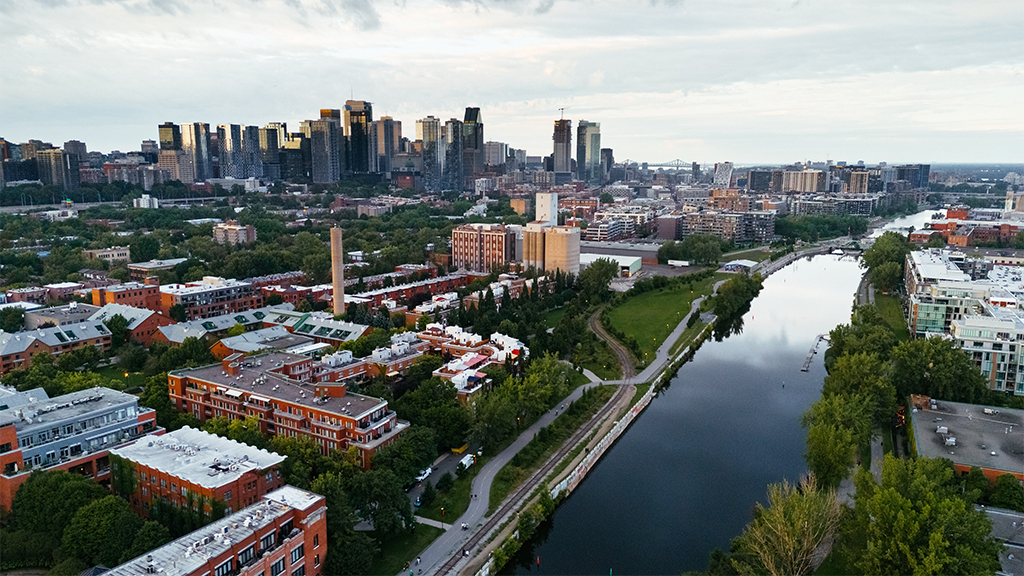It used to be that on New Year’s Eve, people living along Montreal’s Lachine Canal would throw open their doors to hear the nearby factories blow their horns when the clocks struck midnight.
That’s one of the stories historian Steven High has heard over and over again from people who lived in the working-class neighbourhoods that bordered the canal. Most of those factories are gone now, and today‚Äôs canal, lined by bike paths and loft condos, would be largely unrecognizable to a time traveller from the 1940s.¬Ý
There are certain landmarks that remain, familiar to many Montrealers ‚Äî the neon-red Farine Five Roses sign near the Old Port, for example, or the decaying ∫⁄¡œ≥‘πœÕ¯ Malting silos further west. But the Lachine Canal, which marks its 200th anniversary this year, is ever-changing. Over two centuries, it has been transformed from an industrial thoroughfare to a neglected backwater to a prime example of urban gentrification.¬Ý
The canal is both an emblem and a microcosm of Montreal, a source of pride and debate. “It’s a place where these forces are most visible in Montreal,” said High, a professor at Concordia University. “You go to the canal … and you can see the city changing before your eyes.”
The idea of a canal to bypass the Lachine Rapids upstream from Montreal is almost as old as the city itself. But early attempts to build one, beginning in the late 17th century, ended in failure.¬Ý
It wasn‚Äôt until 1821 that work began in earnest, driven by Montreal merchants who wanted to turn the city into a commercial hub by opening a passage up the St. Lawrence River. They felt the threat of the Erie Canal, then under construction, which would connect the Great Lakes to the Hudson River and turn New York City into a major port. ¬Ý
The 14-kilometre Lachine Canal, which opened in 1825, was built largely by Irish immigrants, who settled in the neighbourhood now called Griffintown, west of the old city. The working conditions were hard, and a bloody labour conflict during an expansion of the canal in 1843 left several people dead.¬Ý
The canal was the first link in a series of canals built along the St. Lawrence River that would allow ships to navigate between the Great Lakes and the Atlantic Ocean, said √âmilie Girard, a historian with L‚Äôusine √Ý histoire(s), an organization offering heritage consulting. It was expanded twice in its first 60 years to accommodate ever-larger ships.¬Ý
The waterway also spurred a wave of industrial development in Montreal, with factories soon cropping up along its banks. They were drawn by the promise of hydraulic energy from the canal’s locks, and by the convenience of dumping their waste straight into the channel.
By the early 20th century, High said, “it’s wall-to-wall factories, right from one end to another.”
The plants ran the gamut, from flour mills to textile and tool factories to the massive Redpath Sugar refinery. According to Parks ∫⁄¡œ≥‘πœÕ¯, more than 600 businesses have occupied land along the canal over its 200-year history.¬Ý
‚ÄúIt became a hot-spot for the entire Canadian economy,‚Äù said Girard.¬Ý
But the heyday wouldn’t last. The waterway was rendered obsolete with the 1959 opening of the St. Lawrence Seaway, which now moves ships through a canal along the river‚Äôs south shore.¬Ý
Most of the factories closed in the years that followed, devastating the working-class communities near the canal. Girard said 40 per cent of the jobs in Montreal‚Äôs southwest disappeared during that time, and many people moved east toward the Port of Montreal.¬Ý
The canal permanently closed to shipping in 1970, and in the years that followed, High said, it was little more than a “drainage ditch.” Some of it was even filled in.¬Ý
The story could have ended there. But in 1978, Parks ∫⁄¡œ≥‘πœÕ¯ took over the site, in what High said was an attempt to plant the Canadian flag after the sovereigntist Parti Qu√©b√©cois formed government for the first time two years earlier.¬Ý
The Lachine Canal was designated a national historic site in 1996, and Parks ∫⁄¡œ≥‘πœÕ¯ launched a major revitalization project the following year. The canal reopened to pleasure boating in 2002, and visitors can now rent kayaks or swan-shaped pedal boats to travel its waters.¬Ý
In the summer, the paths along the canal fill up with cyclists and joggers. Climbers can scale the abandoned, 38-metre silos of the Redpath refinery, repurposed by a Montreal climbing gym. Girard said more than one million people now visit the canal every year for recreation.
These days, large stretches of the canal are lined with upscale condos, with still more under construction. Just beside the climbing silos, the old Redpath refinery has been converted into red-brick lofts, for those who can afford to buy a little piece of history.¬Ý
Florian Mayneris, an economics professor at the Universit√© du Qu√©bec √Ý Montr√©al, said the revitalization of the canal has caused the area to gentrify more rapidly than other central Montreal neighbourhoods.¬Ý
Last year, the City of Montreal launched a new project to draw business back to the canal, but with a distinctly 21st-century flavour. Gone are the days of heavy industry — the city now wants to attract tech startups and social economy enterprises where the factories used to be, said Benoît Dorais, mayor of Montreal’s southwest borough.
Not everyone is happy about the gentrification of the Lachine Canal. A years-long battle over the abandoned ∫⁄¡œ≥‘πœÕ¯ Malting silos saw a community group push for affordable housing instead of another condo project planned by a Montreal developer.¬Ý
But the reality is that condo developers are often the only ones who can afford to renovate old industrial sites. “There‚Äôs a lot of decontamination,‚Äù said Dorais. ‚ÄúAnd you have to keep certain heritage aspects and then restore them. That‚Äôs extremely expensive.‚Äù
Dorais said the developer now has all the rights to build on the ∫⁄¡œ≥‘πœÕ¯ Malting site, but to date no construction has begun.¬Ý
The upshot of all this restoration, according to High, is that developers are preserving the cachet of old silos and red-brick facades for the benefit of people with no link to the area’s working-class history.
“People had a multi-generational connection to these neighbourhoods ‚Ķ and now they can’t afford to live in them anymore,” he said.¬Ý
Two hundred years on, the Lachine Canal has cemented its legacy as an engine of Montreal’s industrial development and a key part of the city’s heritage. What its future should look like is less clear.¬Ý
“Where does heritage rest?” High said. “Does it rest in bricks and mortar? Or is it actually in the communities and in the people themselves?”
©2024 The Canadian Press
03





Recent Comments
comments for this post are closed